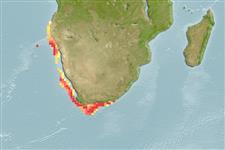Lớp phụ Cá sụn (cá mập và cá đuối) (sharks and rays) >
Rajiformes (Skates and rays) >
Gurgesiellidae (Pygmy skates)
Etymology: Cruriraja: Latin, crur, cruris = pertaining to a leg + Latin, raja = a ray (Raja sp) (Ref. 45335); hulleyi: Named for P.A. ‘‘Butch’’ Hulley, for his pioneering research on southern African skates..
Environment: milieu / climate zone / depth range / distribution range
Sinh thái học
Biển Sống nổi và đáy; Mức độ sâu 39 - 545 m (Ref. 85323), usually 200 - 500 m (Ref. 85323). Subtropical
Southeast Atlantic: Lüderitz, Namibia to Algoa (and possibly East London) on the Eastern Cape coast of South Africa.
Bộ gần gũi / Khối lượng (Trọng lượng) / Age
Maturity: Lm ? range ? - ? cm
Max length : 58.0 cm TL con đực/không giới tính; (Ref. 85323); 59.4 cm TL (female)
Short description
Hình thái học | Sinh trắc học
This species is distinct from its congeners in having the following characters: spatulate distal ends of the anterior pelvic lobes (wider tip in C. cadenati, tapering in others); dorsal mid-disk and tail with continuous semiparallel rows of thorns in adults (no thorns on mid-disk in C. rugosa, present on midline in others); claspers with small, flattened process (boss) on accessory terminal 2 cartilage and blind-ended sac with posterior opening at the distal end of the clasper (sentina), both unique within genus to C. hulleyi; interdorsal thorns 6 (none in C. durbanensis, 2 in C. parcomaculata, 4 in C. poeyi, 1 in C. rugosa, many in C. atlantis). This species is further distinguished from its congeners by the following set of characters: interdorsal distance greater than half, and not exceeding, dorsal-fin base length (vs. at least 1.5 times dorsal-fin base length in C. atlantis, half or less dorsal-fin base length in C. parcomaculata); outer lateral margin of clasper dorsal marginal cartilage elongated and bluntly rounded (truncate in C. rugosa); proximal margin of dorsal terminal I cartilage forms a point (a series of points in C. rugosa); distal point (eperon) of ventral terminal cartilage relatively narrow and claw-like (bifurcate in C. parcomaculata, expanded in C. rugosa); ventral surface of clasper without dermal denticles (present in C. parcomaculata) (Ref. .85323).
Reported to be a moderately common species of the outer shelf and upper continental slope, 39-545 m deep, but most common between 200 and 500 depth. Larger individuals tend to occur on the west coast of southern Africa, while those on the south coast are slightly smaller. The egg case was described to be small, vase-like, measuring less than 50 mm long excluding horns, surface coarsely striated, and with very narrow lateral keels, <1% of maximum egg case width; its posterior horns are approximately 45% longer than the anterior horns, tapering to thin tips, curving inwards and with fine attachment fibers; the anterior horns are hook-shaped, with acute tips (Ref. 85323).
Life cycle and mating behavior
Chín muồi sinh dục | Sự tái sinh sản | Đẻ trứng | Các trứng | Sự sinh sản | Ấu trùng
Aschliman, N.C., D.A. Ebert and L.J.V. Compagno, 2010. A new legskate (Rajoidei: Genus Cruriraja) from Southern Africa. Copeia 2010(3):364-372. (Ref. 85323)
IUCN Red List Status (Ref. 130435)
Threat to humans
Harmless
Human uses
Thêm thông tin
Age/SizeSự sinh trưởngLength-weightLength-lengthLength-frequenciesSinh trắc họcHình thái họcẤu trùngSự biến động ấu trùngBổ xungSự phong phúBRUVS
Các tài liệu tham khảoNuôi trồng thủy sảnTổng quan nuôi trồng thủy sảnCác giốngDi truyềnElectrophoresesDi sảnCác bệnhChế biếnNutrientsMass conversion
Các công cụ
Special reports
Download XML
Các nguồn internet
Estimates based on models
Preferred temperature (Ref.
123201): 6.7 - 14, mean 9.5 °C (based on 54 cells).
Phylogenetic diversity index (Ref.
82804): PD
50 = 0.5039 [Uniqueness, from 0.5 = low to 2.0 = high].
Bayesian length-weight: a=0.00661 (0.00225 - 0.01943), b=2.95 (2.71 - 3.19), in cm total length, based on LWR estimates for this (Sub)family-body shape (Ref.
93245).
Mức dinh dưỡng (Ref.
69278): 3.9 ±0.6 se; based on size and trophs of closest relatives
Fishing Vulnerability (Ref.
59153): Moderate vulnerability (44 of 100).
